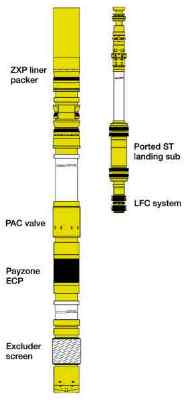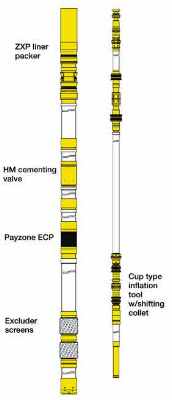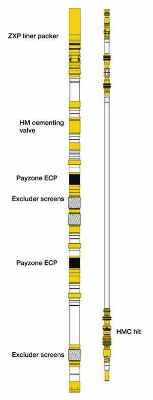Cementing above screens and slotted liners
DRILLING / COMPLETION TECHNOLOGYCementing above screens and slotted linersWhere it is desirable to isolate slotted liners and screens, new cementing tools / methods improve results and reduce the number of tripsRay Vincent, Baker Oil Tools
Reasons For Cementing Cementing above a slotted liner or screen may be dictated by one of the events described below. Lost-circulation zone. A lost-circulation zone is defined as one in which there is total or partial loss of drilling fluids or cement slurries into highly permeable zones, cavernous formations and natural fractures or induced fractures from drilling or cementing operations.1 In these types of zones, placing a barrier, i.e., an ECP, above the lost-circulation zone removes the hydrostatic overburden pressure. Fluid loss ends, and cementing above the ECP can begin. Cement-sensitive zone. A cement-sensitive zone is one in which formation damage can occur during cementing due to solids that plug pores, vugs or fractures. Mud-flushing chemicals may produce changes that can alter formation clays. Placing an ECP barrier above the cement-sensitive zone can protect the formation from solids damage and from chemical-flushing problems. With the formation protected, cementing above the ECP can begin. Gas isolation. Gas migration may occur during cement operations as gelation (from liquid to solid state) begins. At this stage, hydrostatic pressure is reduced, thereby allowing gas into the cement column.2 Gas entering the cement can produce channels and wormholes in the cement sheath. These passages, i.e., micro-annuli, allow communication with other zones or liner-top leakage. By placing an ECP barrier above the zone, gas migration is not permitted to enter the producing zone after cementing. The barrier prevents channels or wormholes to the producing formation below and acts as a base for the cemented liner above.
Achieving a good, primary cement job in a horizontal well. High inclination angles that do not allow the operator to rotate or reciprocate the casing while cementing may prevent the cement sheath from being circumferentially continuous. This may create channels back to the vertical wellbore section. ECP(s) can be placed near the heel of the horizontal section to support the cement column in the build section. If needed, such barriers can be placed within the horizontal section and sequentially inflated for zone isolation. Cementing Above Slotted Liner / Screen Methods for cementing above slotted liners or screens are discussed below. Stage cementing using PAC valve and ECP. In stage cementing, a port collar, or Pressure Actuated Cementing (PAC) valve, placed above the liner shoe within the liner string, is selectively opened to provide an intermediate cement passage to the annulus, Fig. 1. Stage cementing with a barrier above a slotted liner or screen has been successfully used throughout the world to simplify operations. It allows protection of the formation or screen with standard cementing procedures. An ECP is mounted directly above the slotted liner, with a landing collar below it and a PAC valve above. Blank liner (as needed for the application) is run above the PAC valve to the liner hanger, which can be either mechanically or hydraulically set. The ECP is inflated, creating a barrier between the blank liner to be cemented and the slotted liner. After inflating the ECP, the PAC valve is opened with additional applied pressure. The liner annulus can then be circulated and conditioned for cementing. After pumping cement, a seal created in the PAC valve allows the valve to be closed hydraulically. The liner-hanger running tools can then be removed from the well, and the drilling assembly run to drill out the ID of the PAC valve, along with excess inflation cement above the landing collar.
One-trip stage cementing. Using a Hydro-Mechanical Cementing Valve (HMCV), ECP and a cup-type inflation tool, one-trip stage cementing saves time by allowing the operator to run and cement in a single trip. It eliminates having to drill excess cement after the job is completed. This method is enabled by an HMCV which is operated with a shifting tool attached to a cup-type inflation tool. Applied pressure opens the HMCV, while upward movement of the cup-type inflation tool closes and locks it. The ECP is mounted directly above the slotted liner, with the cementing valve above the ECP. An optional, slimhole landing collar can be used to identify the cement slurry tail. After cementing, a drain valve located above the cup-type inflation tool is opened, and circulation is initiated to clean out excess cement. No drillout of plugs or landing collars is required. This technique has proven particularly valuable on Alaska’s North Slope, where it has saved two trips – one for run-in and one for drillout – per well. New One-Trip Technique This one-trip, stage-cementing method employs a hydro-mechanical-cementing valve, multiple ECPs and a hydro-mechanical-cementing, horizontal-inflation tool. This new technique expands the timesaving benefits of the one-trip, stage-cementing process described above. Multiple ECPs – placed within a slotted liner in a horizontal section – can be cement-inflated, and cementing can be accomplished above the uppermost ECP – all in one trip. The uppermost ECP is mounted directly above the slotted liner, with the HMCV mounted above that. Before attaching the liner hanger to the liner, a Hydro-Mechanical Cementing, Horizontal Inflation Tool (HMC HIT) is run inside the liner on an inner string. After setting the liner hanger and releasing the running tool, the HMC HIT is tested and then moved to the lowermost ECP. A pump-down plug is launched from the surface with inflation cement following. When the pump-down plug reaches the HMC HIT, inflation of the first ECP commences. The HMC HIT is moved uphole to other ECPs, carrying the inflation cement. No cement is allowed to escape the inner string. Each ECP is inflated using the HMC HIT. The uppermost ECP becomes the barrier between the liner to be cemented and the slotted liner. After all ECPs are inflated, the HMC HIT is moved to the cementing valve. Applied pressure opens the cementing valve, and circulating / conditioning of the liner annulus begins. Cement is then pumped and displaced with drilling fluid. Just as with the single-ECP, one-trip, stage-cementing process described above, following cementing, a drain valve located above the cup-type inflation tool is opened, and circulation is initiated to clean out excess cement. An optional, slimhole landing collar can be used to identify the cement slurry tail. No drillout of plugs or landing collars is required. Although relatively new, this method already has an
impressive performance record in the North Sea, where it has saved up to three trips per
well. Literature Cited
The authorRay Vincent works as a senior applications specialist with Baker Oil Tools’ Open Hole Completions group in Houston. He earned a BSc from the University of New Orleans and has worked for various completion service companies. He joined Baker in 1994. |
- Applying ultra-deep LWD resistivity technology successfully in a SAGD operation (May 2019)
- Adoption of wireless intelligent completions advances (May 2019)
- Majors double down as takeaway crunch eases (April 2019)
- What’s new in well logging and formation evaluation (April 2019)
- Qualification of a 20,000-psi subsea BOP: A collaborative approach (February 2019)
- ConocoPhillips’ Greg Leveille sees rapid trajectory of technical advancement continuing (February 2019)





